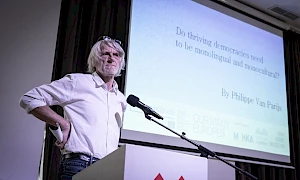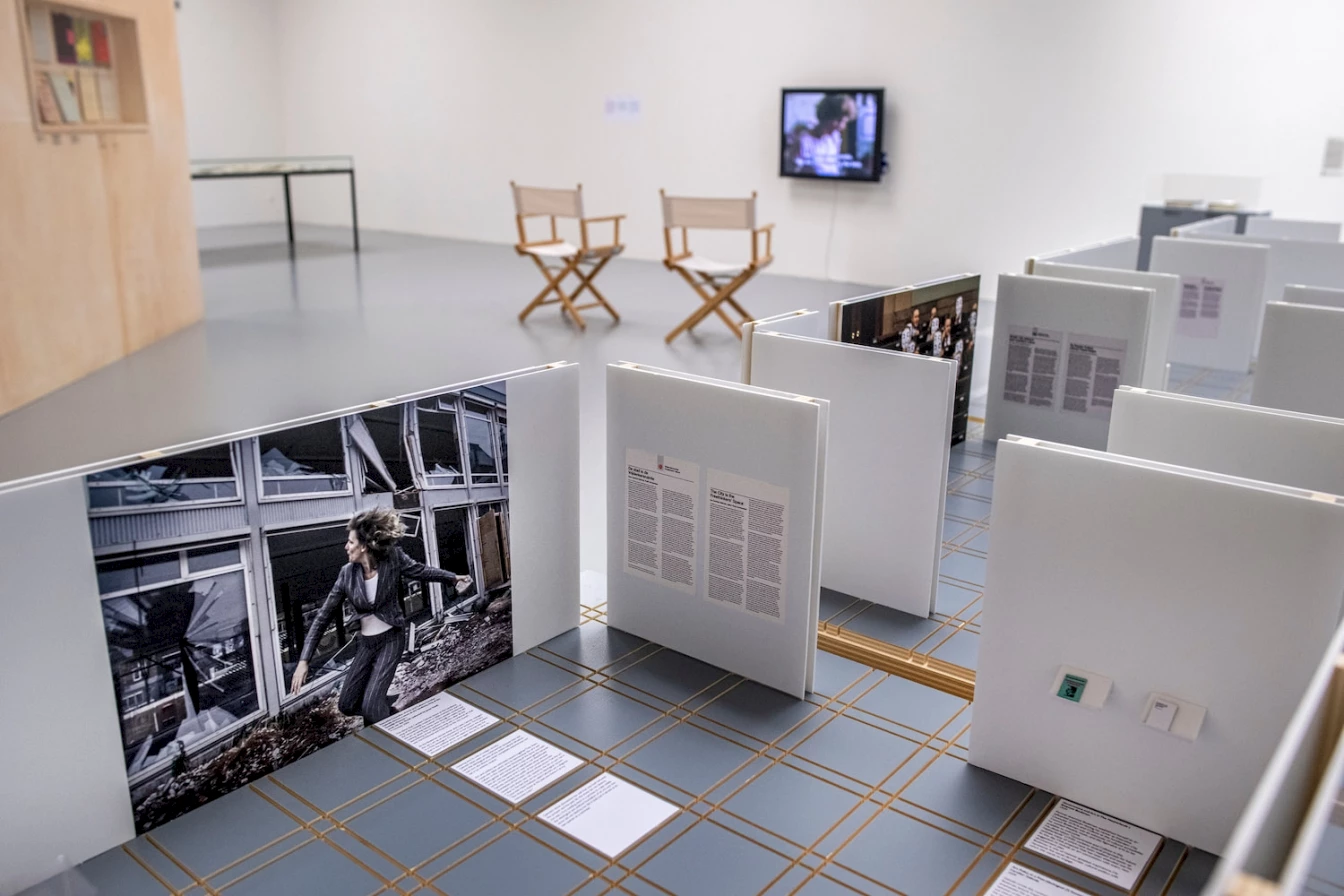
Jonas Staal, Vrijdenkersruimte Vervolgd, 2012. Photo: M HKA, Wim Van Eeesbeek.
Why resurrect it all now. From the Past. History, the old wound. The past emotions all over again. To confess to relive the same folly. To name it now so as not to repeat history in oblivion. To extract each fragment by each fragment from the word from the image another word another image the reply that will not repeat history in oblivion.
–Theresa Hak Kyung Cha, Dictée1
The scramble suit represents one of our oldest dreams: that of escaping the body. In the ancient world, octopuses were valued for their ability to change shape as they merge with their surroundings – in the case of the mimic octopus, they can change colour too. The polytropic Odysseus, clinging onto a rock to avoid being carried off by the waves, is compared to an octopus. […] It was better, wrote Theognis, to have the craft and cunning of an octopus than to be atropiis (unchangeable).
–Will Harris, Mixed-Race Superman2
Consent not to be a single being.
–Fred Moten, Black and Blur3
Containers
This text is a subjective paratext, a pretext, a post-text, a post-face to monoculture, both MONOCULTURE: A Recent History, the exhibition, conference,4 publication5 initiated by curator Nav Haq at M HKA, and ‘monoculture’, the term. MONOCULTURE unfolds through time and space in a plurality of artistic, curatorial, editorial, discursive formats, just as its core concept (monoculture or ‘cultural homogeneity’)6 questionably traverses many fields of enquiry, from agriculture to politics, economy to sociology, anthropology to artistic production. And to such an extent that Haq and editor Pascal Gielen pluralise the term in their introductory text to the publication The Aesthetics of Ambiguity.7 Indeed, as paradoxical as it may seem, monoculture is not a ‘universe’ but a ‘pluriverse’,8 which MONOCULTURE, the exhibition, reverberates within.
It follows that this text can only exist as a partial container for some of MONOCULTURE’s many pressing topics.9 It attempts to carry the paths which I traced while visiting the exhibition, reading its publication and attending its conference. It also attempts to tell stories that respond to those paths – the octopus has many limbs and its soft body keeps changing colour. But while this container may fail at embracing MONOCULTURE, so does the project itself in many ways; monoculture is so plural that it is impossible to contain – ‘Pluralism bites too strong’.10
Indeed, MONOCULTURE and the concept are un-containable. The entry points into the term and the exhibition are too numerous and the meanings too diverse to arrive at a single definition; one can only observe its various modes and its coexistence with its so-called opposite: ‘multiculture’ or ‘cultural diversity’.11 Monoculture is also, significantly, a recursive concept. And it’s always there somewhere, sometimes partially hidden – it’s a haunting concept. Monoculture is equivocal to the extent that disambiguation doesn’t seem a relevant path to take.12 Monoculture and MONOCULTURE are therefore tricky, even slippery, which may explain why they trouble me. But that is also what makes the term interesting.
Divergent Variations
The text stays with this trouble as it itself unfolds through a series of connections, which hopefully reverberate with those of monoculture and MONOCULTURE. I would like this text to keep haunting me, and you, when it comes to thinking about otherness and the knots that weave ‘us’ and ‘them’ together. Just as Pascal Gielen and Nav Haq ‘start with a simple statement of “relations”’, feminist theorist Karen Barad opens her essay ‘On Touching – The Inhuman That Therefore I Am’ with the following questions: ‘When two hands touch, how close are they? What is the measure of closeness? Which disciplinary knowledge formations, political parties, religious and cultural traditions, infectious disease authorities, immigration officials, and policymakers do not have a stake in, if not a measured answer to, this question?’13 Approaching ‘touch’ through the lens of quantum field theory, Barad shows that just like particles human beings move and evolve through a series of inter- and intra-actions, which testifies to the queer entanglement of things: ‘All touching entails an infinite alterity, so that touching the other is touching all others, including the “self”, and touching the “self” entails touching the strangers within. … Every finite being is always already threaded through with an infinite alterity diffracted through being and time.’14 Alterity emerges through an infinite active process of differentiation, an ‘entangled relation of difference (différance)’.15
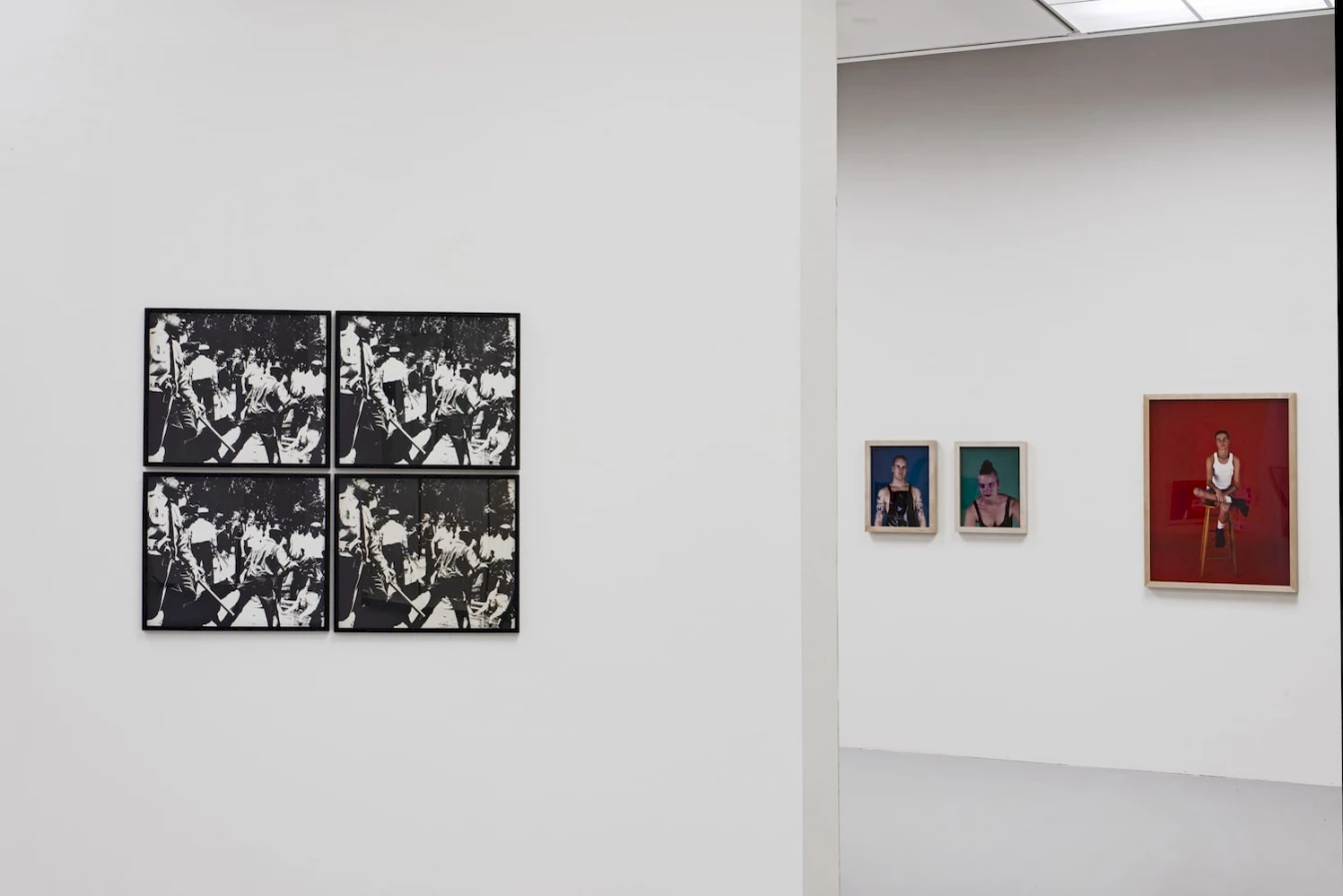
Andy Warhol, Birmingham Race Riot, 1964. Photo: M HKA, Wim Van Eeesbeek.
Reading this I can’t help but think that these processes resonate with political philosopher Chantal Mouffe’s thoughts on human identities and conflicts.16 For Mouffe, as well as for Barad, any identity is relational. The notion of écarts différentiels (divergent variations), which Mouffe borrows from anthropologist Claude Lévi-Strauss,17 describes this active, inherent tension between individuals and cultures through which identities emerge: for an ‘us’ to emerge, there always needs to be a ‘them’. In this sense, monoculture is constituted by the affirmation of a difference (différance) with regards to a ‘constitutive outside’.18 The irreducible relationality between monoculture and its so-called opposites (say, polyculture) is one of ‘being bound to the other’;19 the one(s) and the other(s) are constantly in touch. Talking about ‘monocultural violence’ also makes sense here20 – tensions are inevitable. But, as Barad shows, there is not only antagonism but also touch.
Diffractions
While Karen Barad uses ‘diffraction’ in relation to infinite alterity,21 I would like to explore the term as a visual tool and as an instrument to think through and with ‘monoculture’; an instrument for seeing is a framework for interpretation, which is, in itself, a practice of theorising.22 Artworks are definitely instruments for seeing and thinking with. This exhibition explores a history of visuality and a history of erasure.23 Within this space, that of erasure, monoculture manifests through the various attempts to obliterate difference, while (hopefully) being doomed to fail. The exhibition proceeds, then, as an enquiry, as a wandering, as a mapping of identity claims, just as ‘diffraction is a mapping of interference’.24
Mapping (Hi)stories
As the exhibition title suggests, a history is told. And yet, MONOCULTURE: A Recent History is also a container for (hi)stories, revolving around a concept that has been constantly appearing and disappearing in a range of fields – it visually echoes both the spiral and the vortex of historical time, as considered by artist Haseeb Ahmed in his contribution to the conference.25 The exhibition is about how these stories resurface, recombine, with and within works of art, around and outside of them, too; how artworks are understood, accompanied and lived with, and sometimes banned and destroyed. It deals with ‘what happens when histories are foreshortened, homogenised and smoothed over; and [our] responsibility for their recovery in all their complexity’.26
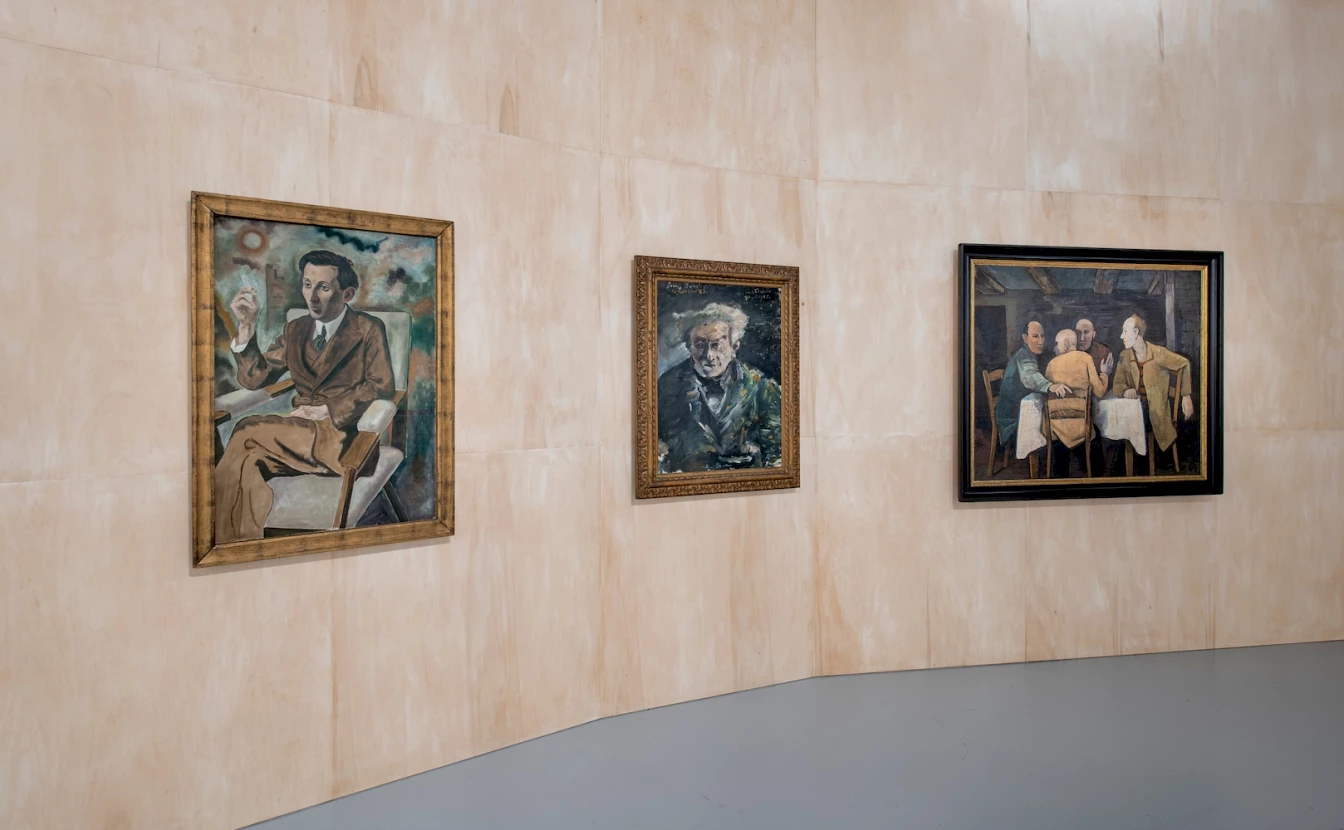
Entartete Kunst, including works by (L-R): George Grosz, Lovis Corinth, Karl Hofer. Photo: M HKA, Wim Van Eeesbeek.
MONOCULTURE particularly loops around a crucial history in Antwerp, in Belgium, in Europe, in the entire world. A pivotal room of the exhibition is dedicated to the infamous exhibition Entartete Kunst (Degenerate Art) in Munich in 1937; just one day before its inauguration, another exhibition opened as a counterpoint: The Great German Art Exhibition.27 Later, in 1939, many works exhibited in Entartete Kunst were sold at auction in Switzerland. The Royal Museum of Fine Arts Antwerp acquired paintings from artists Lovis Corinth, George Grosz and Karl Hofer as a way to save key artworks from destruction, but also as an opportunistic purchase. These paintings are on display in MONOCULTURE.
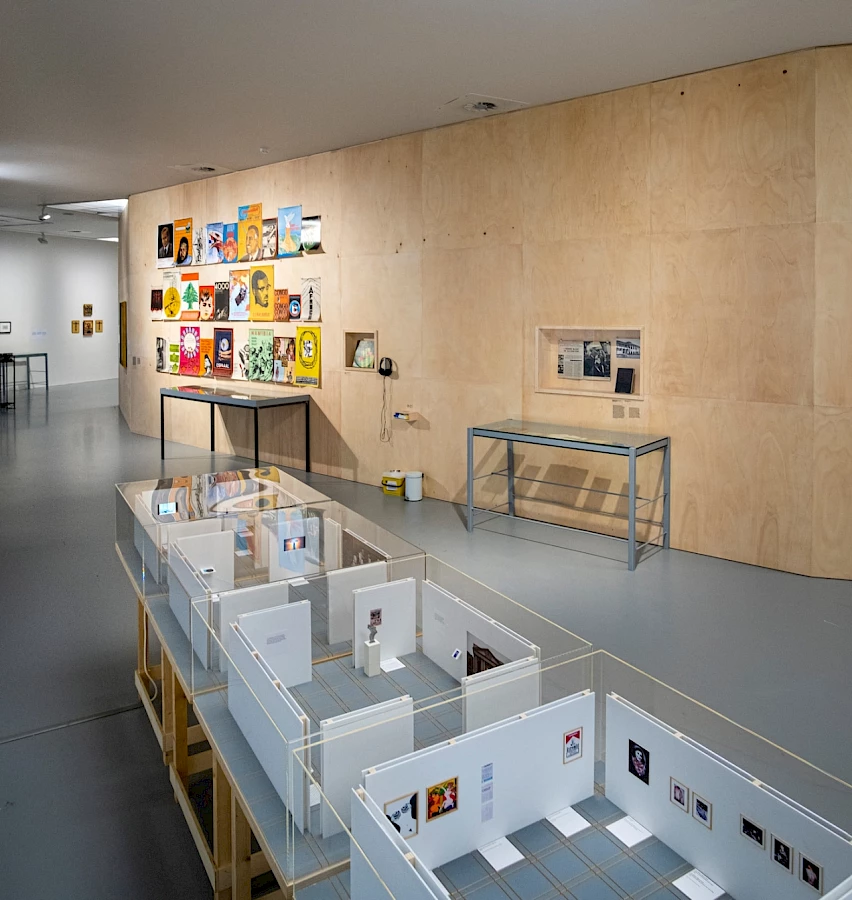
Jonas Staal, Vrijdenkersruimte Vervolgd, 2012. Photo: M HKA, Wim Van Eeesbeek.
Not only was World War II an intense period when monocultural ideologies came to the fore, it also reveals the entanglements between ideology, propaganda, cultural and market value. MONOCULTURE discloses these, while pointing to other ambivalences and occurrences: ‘Entartete did not arise in a vacuum. It is a way of seeing; a persistence of vision.’28 This persistence is found in artist Jonas Staal’s work in the exhibition, Vrijdenkersruimte Vervolgd (Freethinkers’ Space Continued), Model 2012 (2012). It is a scale model of the original Freethinkers’ Space, ‘the first-ever exhibition space created in Dutch parliament in the political offices of the conservative-liberal People’s Party for Freedom and Democracy (VVD) and the ultranationalist Freedom Party (PVV), from 2008 to 2010', which claimed to offer a space to artists supposedly affected by ‘Islamic censorship’.29 Staal further states that this space ‘employ[ed] the degenerate art trope’ in reverse, and aimed to ‘expose the “degeneracy” of the ruling cultural elite that was unwilling to step to defend the freedom of speech of white “autochthonous” citizens’.30 The artist traces this persistence of staging exhibitions as propaganda tools, so to designate a ‘them’, from Entartete Kunst in 1937, Der ewige Jude (The Eternal Jew) in Munich that same year, Entartete Musik in 1938 to the use of modernist art for propagandistic claims of cultural supremacy in the United States during the Cold War – ‘The Entartete Kunst exhibition never entirely closed’.31
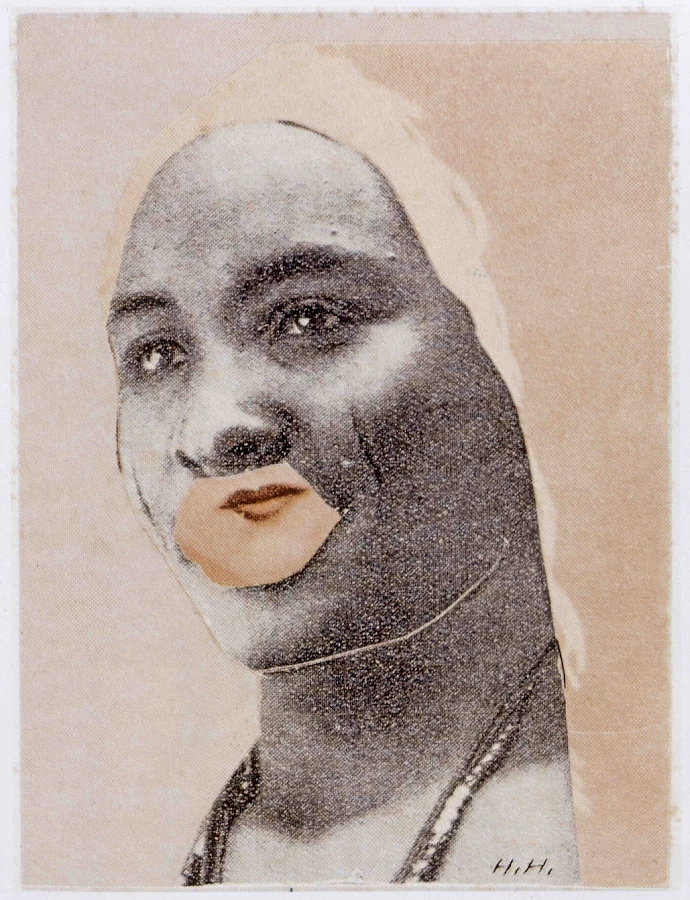
Hannah Höch, Mischling (Mixed Race), 1924. Photo: Liedtke & Michel.
Monocultural Violence
Crucial to the entire MONOCULTURE project is a collage by German artist Hannah Höch, who was deemed ‘degenerate’. Mischling (Mixed-Race, 1924) shows an irreducible entanglement that suggests ‘to see race differently: not as a fixed sign but as a fluid signifier … No single idea can make sense on its own, but no two ideas can be grasped simultaneously. The mixed-race person embodies this’.32 Yet while Höch’s Mischling sits in the exhibition space as a dissonance yet harmonious embodiment of ambiguity,33 monocultural violence is occurring everywhere. Indeed, as philosopher Judith Butler writes, ‘the visual field is not neutral to the question of race; it is itself a racial formation, an episteme, hegemonic and forceful’.34 And accompanied by Olivier Marboeuf: ‘The production of a “we” definitely cost a lot somewhere else’, and ‘there is no “we” without violence’.35 This systemic violence relies on a series of modernist separations, the first being the nature/culture divide. This primary divide contributes to a series of others, one being the human/non-human divide which allowed for the birth of capitalism through the plantation – the paragon of private property and colonisation. Ibrahim Mahama’s On Monumental Silences (2018), along with Vincent Meessen’s The Intruder (2005) and How to Spin a Bad Yarn (2020), as well as many other works in the exhibition incorporate these cruel dualistic intricacies. Just as Renzo Martens and CATPC’s White Cube (2020) ‘relates to the history of museums and how they were founded by people who were cultivating their wealth through setting up plantations, like Henry Tate or Peter Ludwig’.36
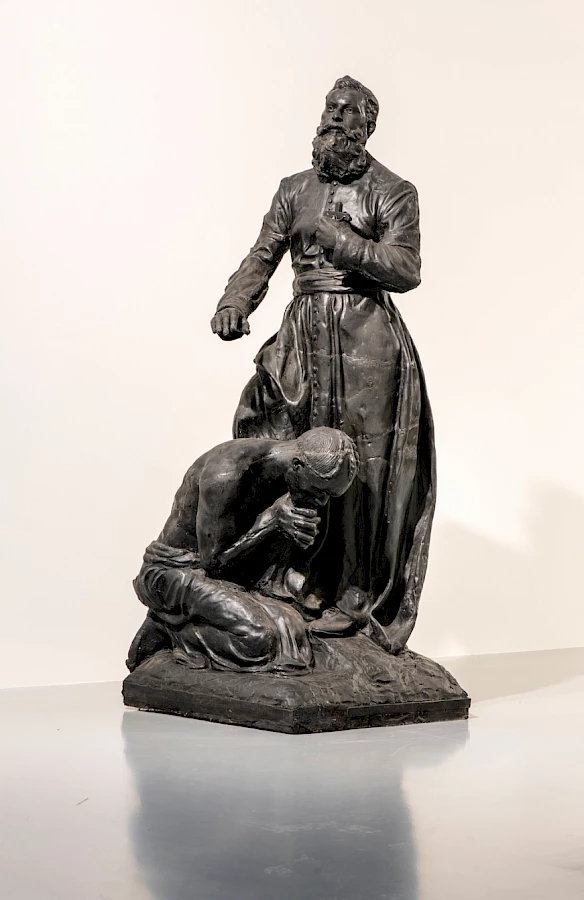
Ibrahim Mahama, On Monumental Silences, 2018. Photo credit: M HKA.
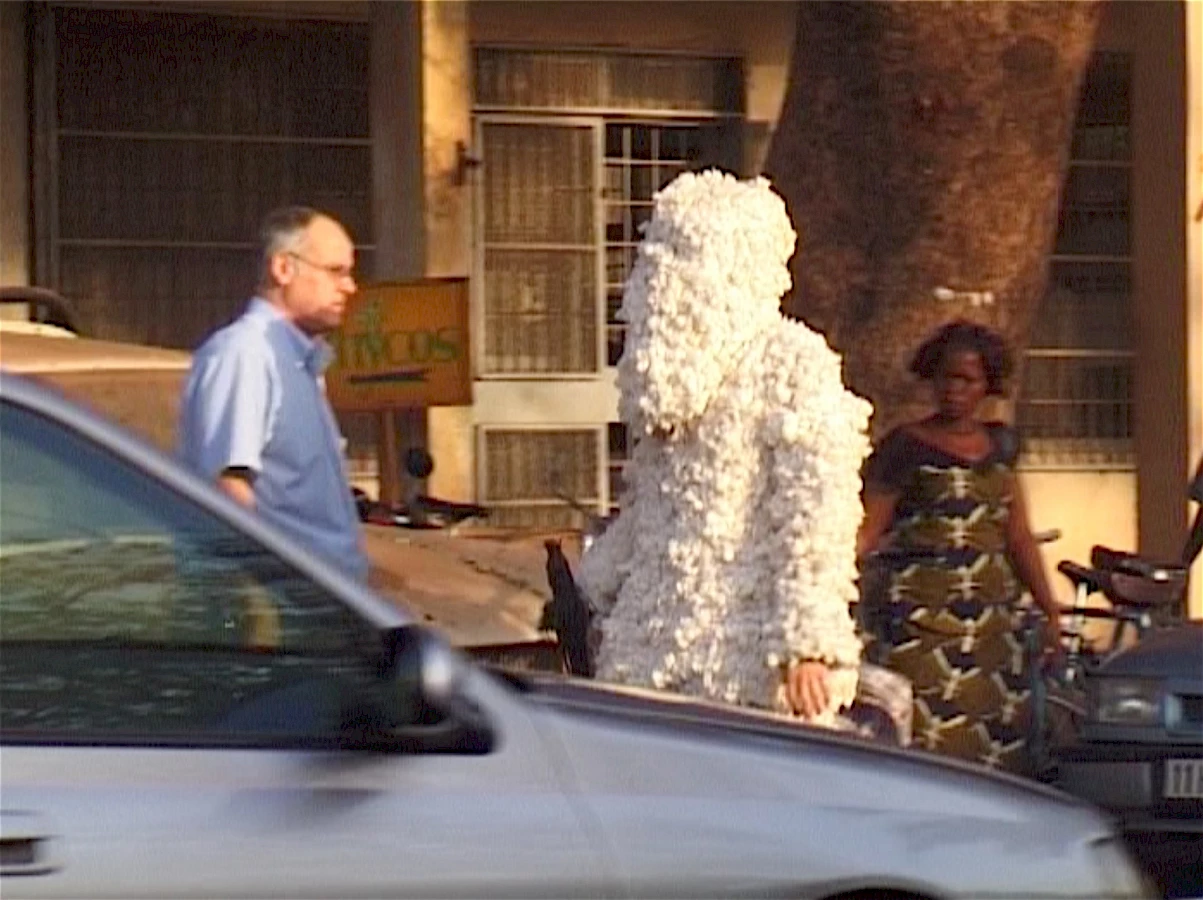
Vincent Meessen, The Intruder, 2005. Image: the artist.

Renzo Martens, White Cube, 2020. Video still. Courtesy of the artist.
The ‘white racist episteme’ is not ‘a static and closed system of seeing, but rather a historically self-renewing practice of reading which, when left uninterrupted, tends to extend its hegemonic force’, again writes Butler.37 MONOCULTURE considers the recurrence of extreme violence – remember the historical vortex. The artworks echo each other in sentiment and testify to this recursive process, this circular reappearance of clashes, where extreme divisions smash up against one another. Andy Warhol’s Birmingham Race Riot (1964) and Philip Guston’s The Law (1969) resonate with the current Black Lives Matter movement,38 while Jos de Gruyter and Harald Thys’s White Suprematism (2016)39 brings consideration to such recent attacks as that on the US Capitol; some aggressors even wore clothing with the English translation of the Nazi infamous ‘Arbeit macht frei’ along with ‘Camp Auschwitz’.
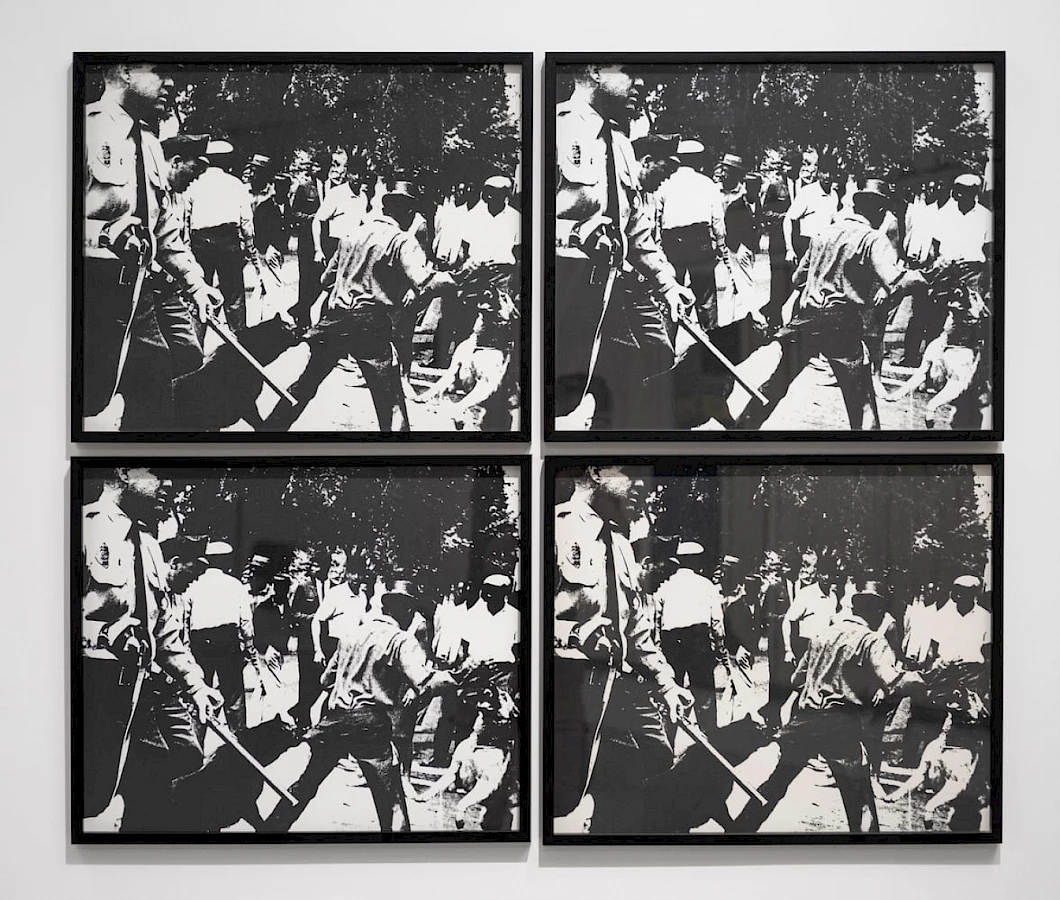
Andy Warhol, Birmingham Race Riot, 1964. Photo: M HKA, Wim Van Eeesbeek.
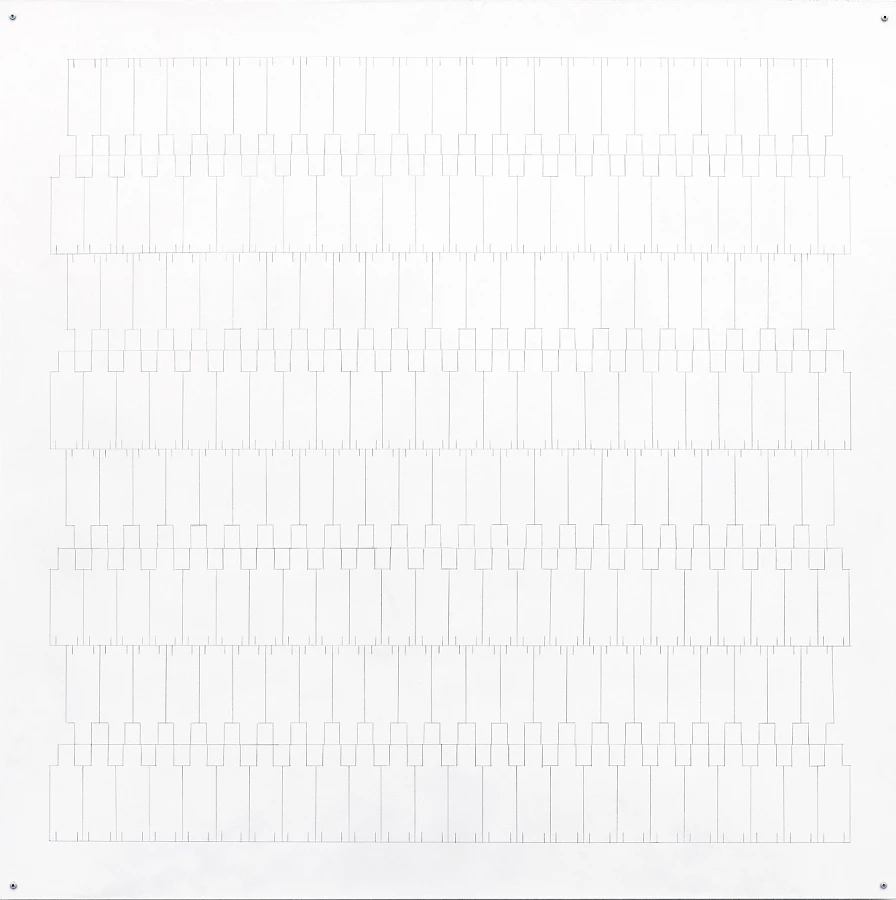
Jos de Gruyter & Harald Thys, White Suprematism, 2016. Photo: Kristien Daem.
The Body as ‘Palmary Instance of the Ambiguous’40
My body is an interface which allows me to interact, to ‘touch’, writes Karen Barad. ‘To have a body is to learn to be affected, meaning “effectuated”, moved, put into motion by other entities, humans or non-humans’, confirms Bruno Latour.41 My body is therefore the recording site of my interactions with the world and the living material through which other entities perceive me.42 As living matter, as the vessel of experiences and affects, the body can become ‘a tool to tell a story or try to explore reality’.43 Bodies are living, archival containers. In MONOCULTURE, many works operate in anarchival mode, which is a subversion of the archival (monocultural) process of recording and suppressing – ‘Archiving and classifying, as acts of domination, speak of their fear of what they are trying to contain. The anarchive is the record of that uncontainability.’44
Now, I would like to invite the story of a black-and-white Pathé newsreel. It shows soldiers throwing books onto a large bonfire, Jewish books, on Opernplatz, Berlin on 10 May 1933. But there’s another part to the story which is relatively unknown, another concomitant process of erasure. On that day not only did the Nazis destroy Jewish books, they also wiped out some of ‘the first academic studies written by and about lesbian, gay, bisexual, intersex and trans people, as well as diaries and personal testimonies, novels, poetry, visual arts, and popular magazines: a whole culture of self-defining queerness’ from the Hirschfeld Institut für Sexualwissenschaft in Berlin.45 What this newsreel reveals is the story of a double erasure, even the echo of collateral erasures. They all relate to the close combination of so-called race and gender that rests within eugenic thinking: ‘The modern concept of the race/gender binary arises from studies intended to prove the claim that race is biological.’46 Hannah Höch’s Mischling resurfaces – it is uncategorisable, uncontainable, not only as an image of mixed-race but also of the androgynous, non-binary. Mischling manifests as ‘queer’ in the sense that it troubles dichotomies. As Barad writes, ‘Q is for queer – the un/doing of identity’.47
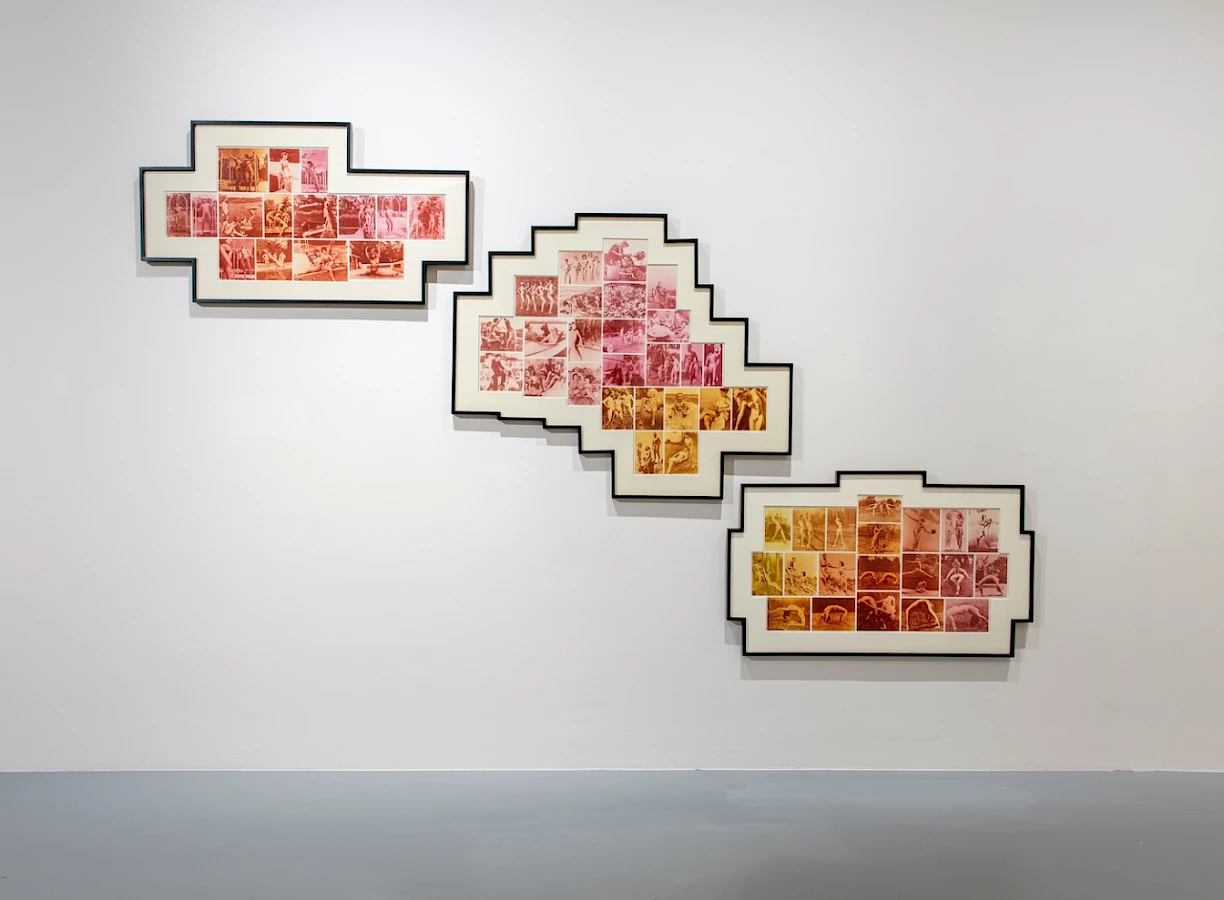
Danny Matthys, Vivre d’Abord, 1979. Photo: M HKA, Wim Van Eeesbeek.
In the exhibition, Danny Matthys’s series of naked, white, young, able bodies explore the historical imaginary of eugenics and Freikörperkultur (Free body culture). The work, as its title indicates, Vivre d’abord (1979) considers the notion of ‘to live, above all’, ‘to live, first’, or ‘to be the first to live’, or ‘even to be the only ones allowed to live’. Felix Gonzales Torres’s UNTITLED (1994) is a white t-shirt which bears the statement ‘Nobody owns me’.48 Such a claim for self-determination relates to how able, healthy bodies are considered valuable for the very same reason that the mentally ill are not. As artist Carol Rama discovered while her mother was in a psychiatric clinic during the era of fascism in Italy: ‘The “abnormals” existed, but they had yet to construct a collective knowledge about themselves; they had no history; they had yet to transform oppression into a critical perspective on power.’49
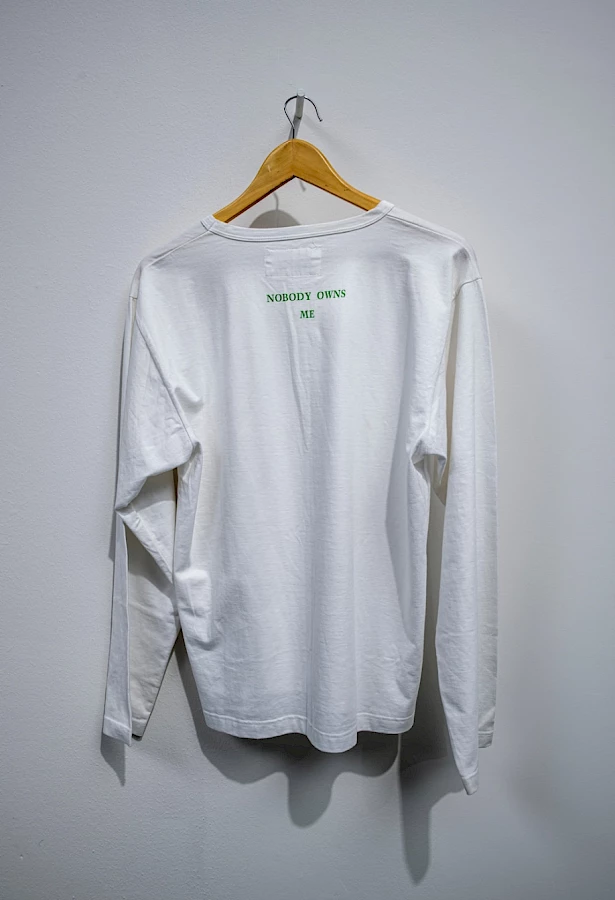
Felix Gonzalez-Torres, UNTITLED, 1994. Photo: M HKA.
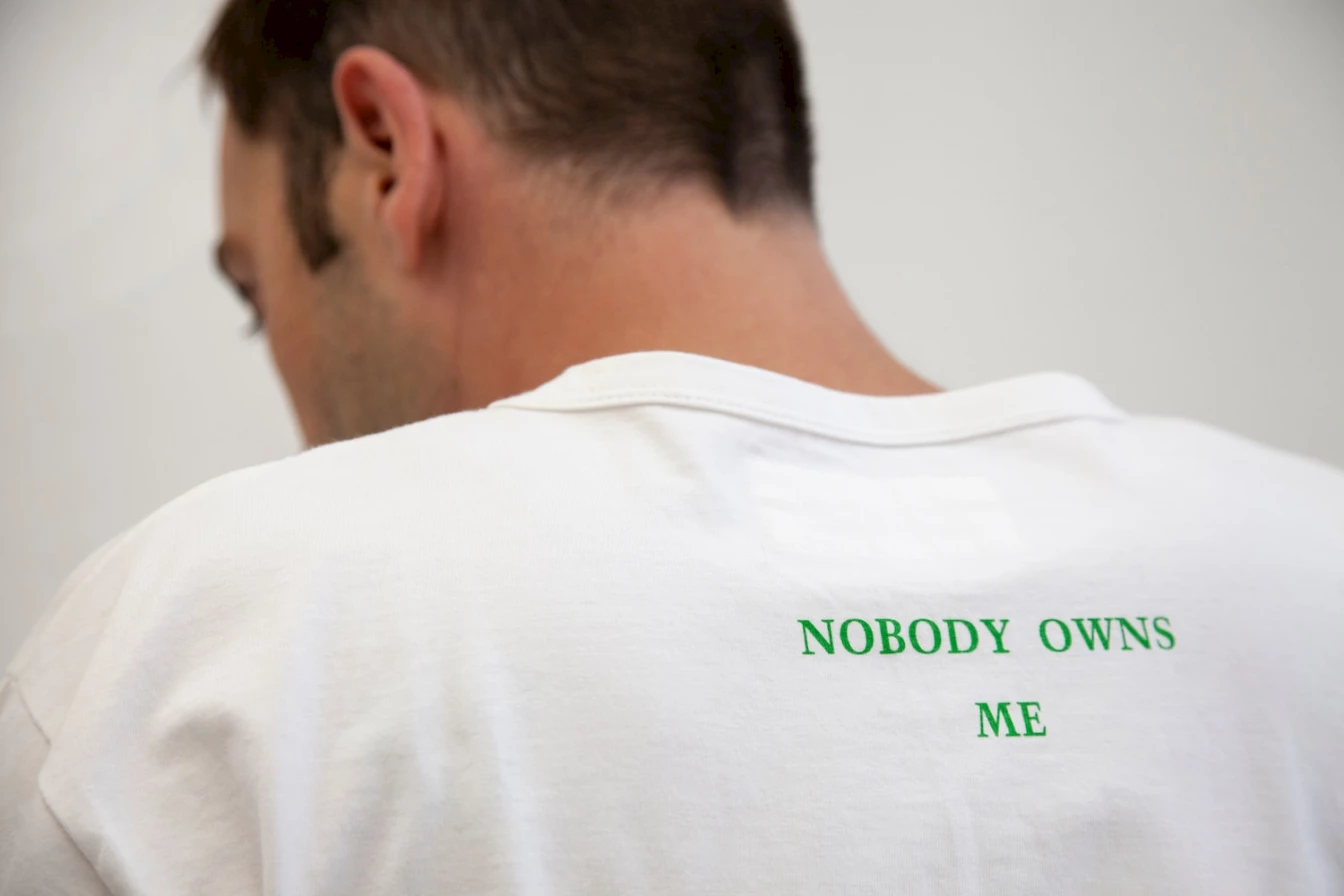
Felix Gonzalez-Torres, UNTITLED, 1994. Photo: M HKA.
Compost
‘Getting rid of lice is not a question of ideology. It is a matter of cleanliness’, wrote Heinrich Himmler, head of the elite Nazi force, the SS.50 Binary readings of the world keep recurring, whether they relate to what is considered human or non-human, nature or culture, clean or not. In the exhibition, Carol Rama’s Marta La Cagona (1940) shows a naked woman defecating; Hüseyin Bahri Alptekin’s Global Digestion (1980–2007) maps a heterogeneous globality through a series of digital prints. For philosopher Paul B. Preciado, hegemony rests on ‘anal castration’ and it was therefore ‘necessary to close up the anus to sublimate pansexual desire, transforming it into the social bond, just as it was necessary to enclose the commons to mark out private property’.51 But while the so-called abject serves as a foil for fixed identities and capitalist production, it may also be precisely that which fertilises the non-human. As writer Elvia Wilk puts it:
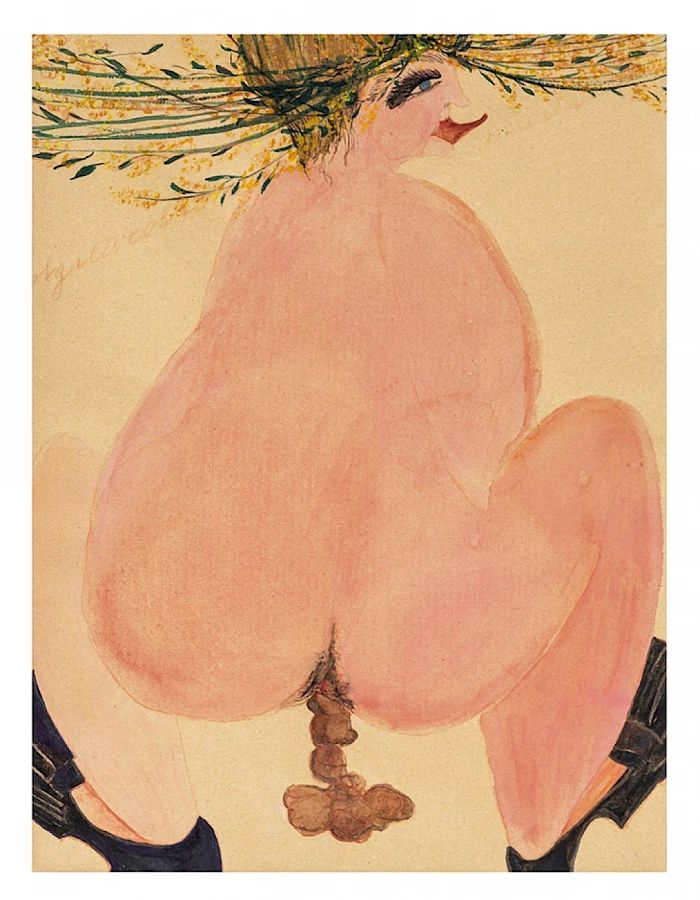
Carol Rama, Marta La Cagona, 1940. © Archivio Carol Rama, Torino. Photo: Beppe Giardino.
The anus is threatening precisely because it is sexy and productive – even reproductive, if shit is understood as manure from which new life grows. Yet that new life is not, at least in the first stage, human life. The worldview required to un-castrate the anus, to reach toward an “anal utopia”, as Preciado has it, would require one to consider nonhuman species as part of an ecosystem in which shit is essential food rather than toxic waste.52
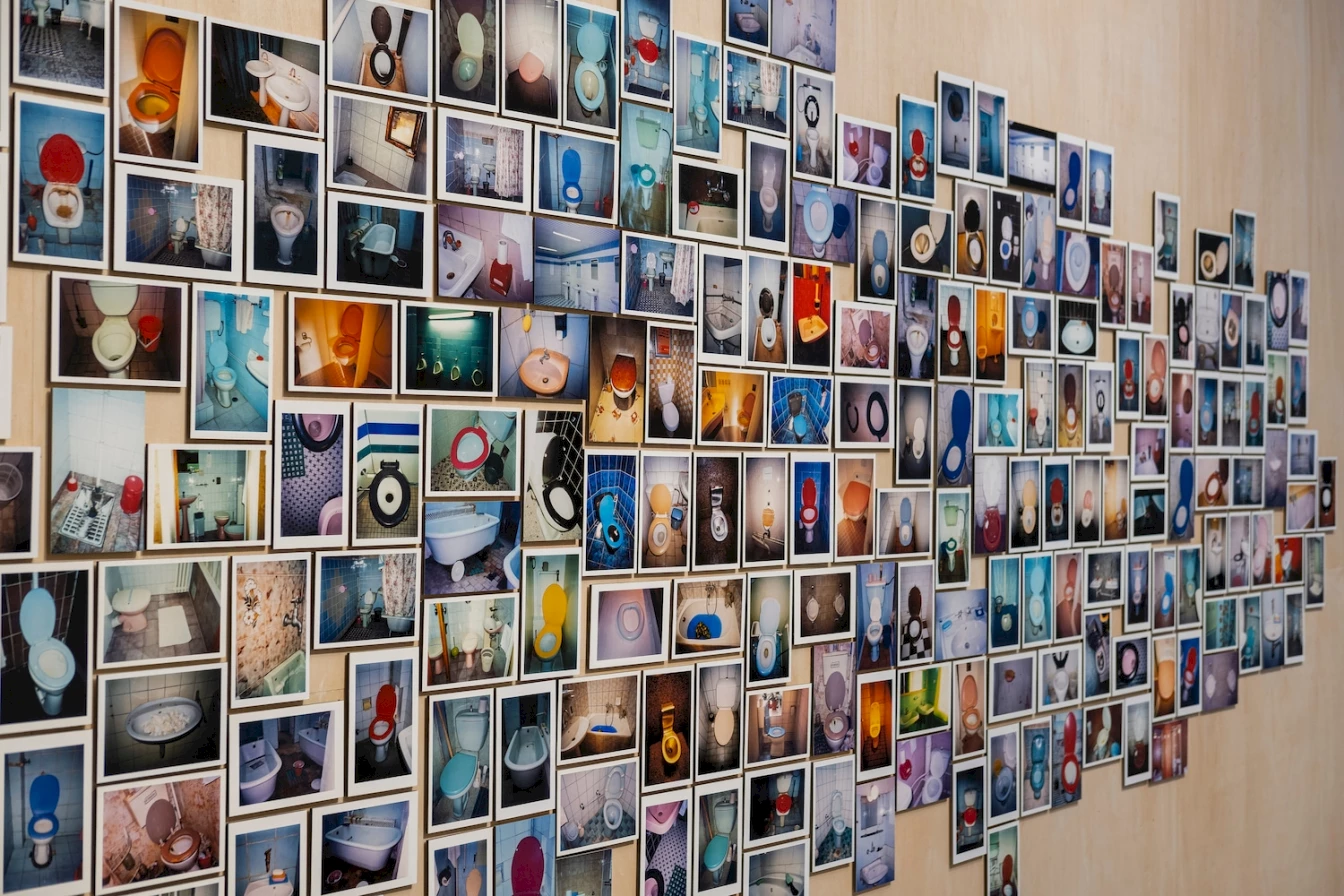
Hüseyin Bahri Alptekin, Global Digestion, c. 1980–2007. Photo: M HKA.
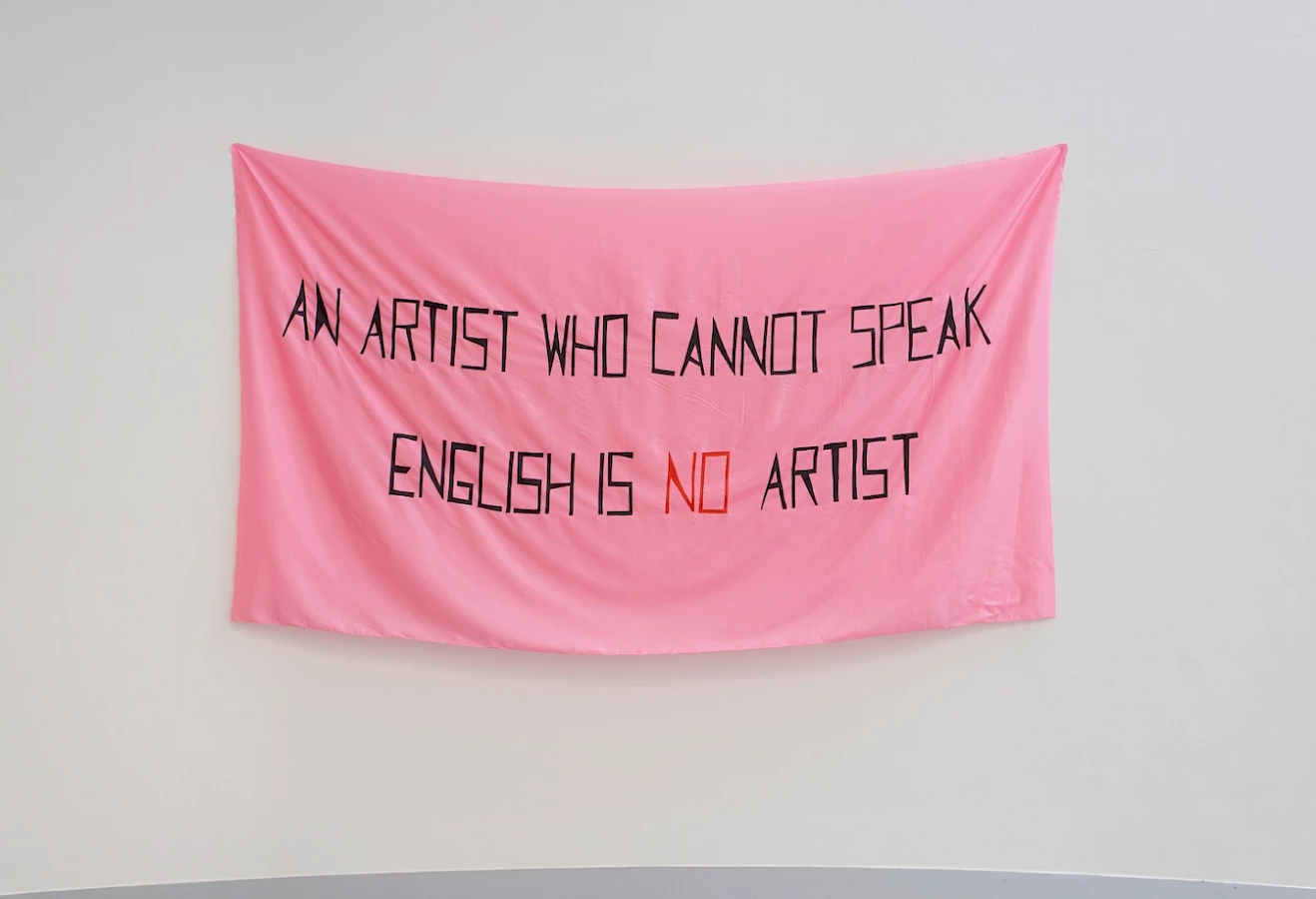
Mladen Stilinovic, An Artist Who Cannot Speak English is No Artist, 1992. Photo: M HKA, Wim Van Eeesbeek.
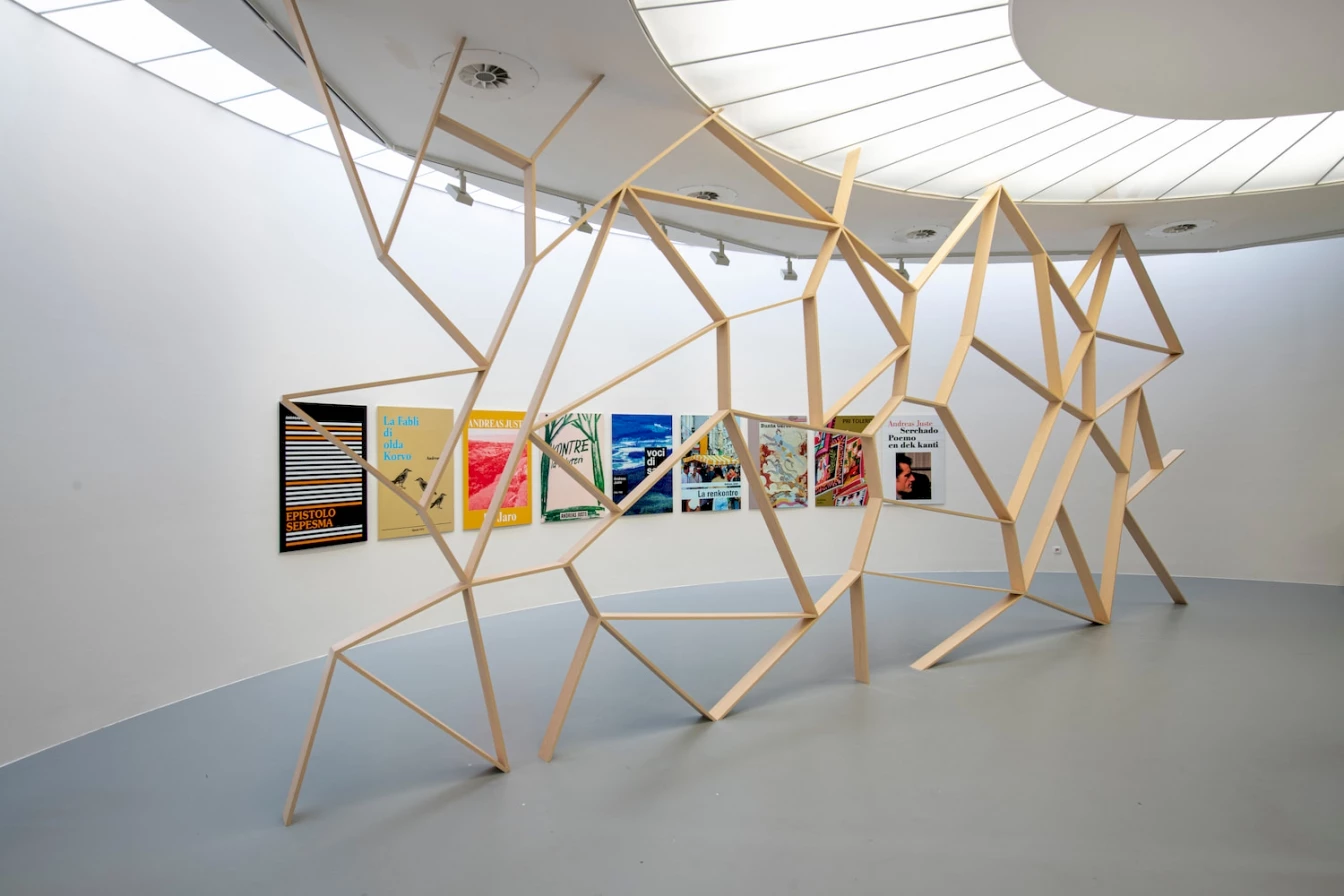
Matti Braun, Bunta Garbo, 2002. Photo: Wim Van Eesbeek.
‘But Who Knows How One Pierces a Dominant Language?’53
MONOCULTURE discloses the various modernist attempts at creating a ‘new’ universal, shareable language as means to promote peace amongst individuals. Consider specifically Matti Braun’s installation Bunta Garbo (2002) on the work of Belgian lawyer and writer Andreas Juste (1918–1998), who invented the ‘universal’ language Ido. But those attempts only reveal the continuous hegemonic impulse, as explicitly stated in Mladen Stilinović’s An Artist Who Cannot Speak English Is No Artist (1992) and Rasheed Araeen’s Oui (1978). ‘Language is not content to go from a first party to a second party, from one who has seen to one who has not, but necessarily goes from a second party to a third party, neither of whom has seen’, write Deleuze and Guattari.54 As with Hannah Höch’s Mischling, language can only compose, combine, mix – compost. Artist Nicoline van Harskamp’s PDGN (2016) develops as a fictional, dystopian narrative that is ‘not-quite-not-English’ in the show,55 and in line with this and as a response to Walter Benjamin’s reflections on ‘pure language’ as the sum of all languages of the world, Korean American poet and translator Don Mee Choi experiments with embodied combinations of wor(l)ds. She follows the routes and transformations of the words Brot and pain (bread) in neocolonial Korea:
The Korean word for bread, ppang, is obviously a transformation or deformation of the word pain. It is most likely that it arrived in Korea already deformed, through the Japanese deformation zone. And if I were to add oksusu, which means corn, in front of ppang – it becomes oksusuppang. Cornbread and oksusuppang do intend the same object, and may even taste the same, except that they arise from very different historical and political intentions. Oksusuppang was fed to school children in South Korea after the Korean War – it was intended as food aid from the US. So my tongue even before it had ever encountered the English language was a site of power takeover, war, wound, deformation, and, ultimately and already, motherless.56
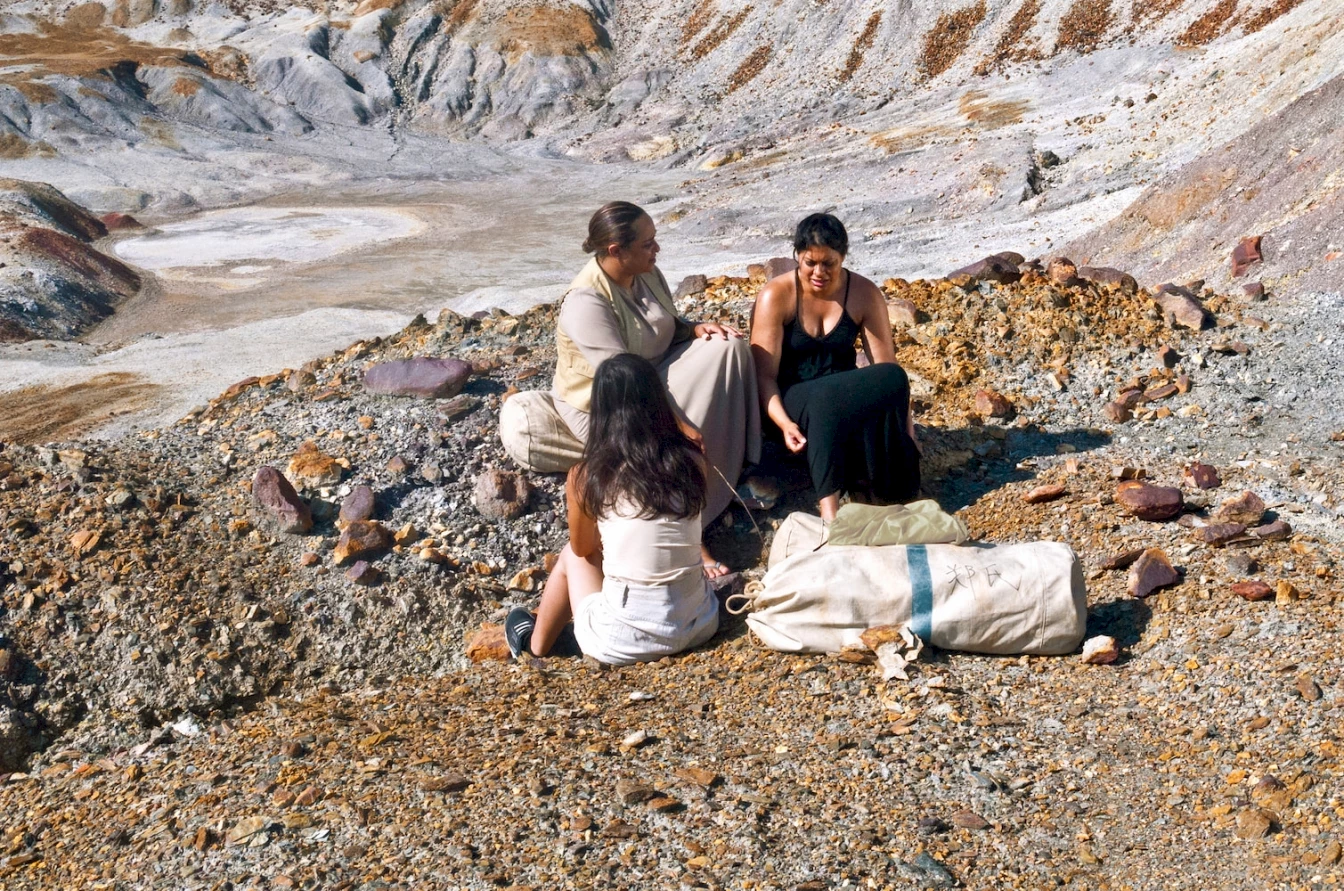
Nicoline van Harskamp, PDGN, 2016. Photo: Bea De Visser.
Hauntological Relations of Inheritance
‘As in Hamlet, the Prince of a rotten State, everything begins by the apparition of a specter’, writes Derrida.57 In MONOCULTURE, ‘hauntological relations of inheritance’58 keep circulating as processes and reversals. Andy Warhol’s Marilyn Monroe (from the Reversal series, ca. 1978), a black-and-white portrait of Monroe in the negative, could give the impression that her skin was black, yet her whiteness is remembered from her highly circulated iconic image. This work resonates with others in the show: again, Hannah Höch’s Mischling, Lynette Yiadom-Boakye’s Nourish the Talented (2003); and from one party to a second party, from a second party to a third party, N.S. Harsha’s Head (2008), which seems to have been cut from its body, falling (or is it flying?) upside down on an empty, white, painted background – ‘Enter the ghost, exit the ghost, re-enter the ghost.’59
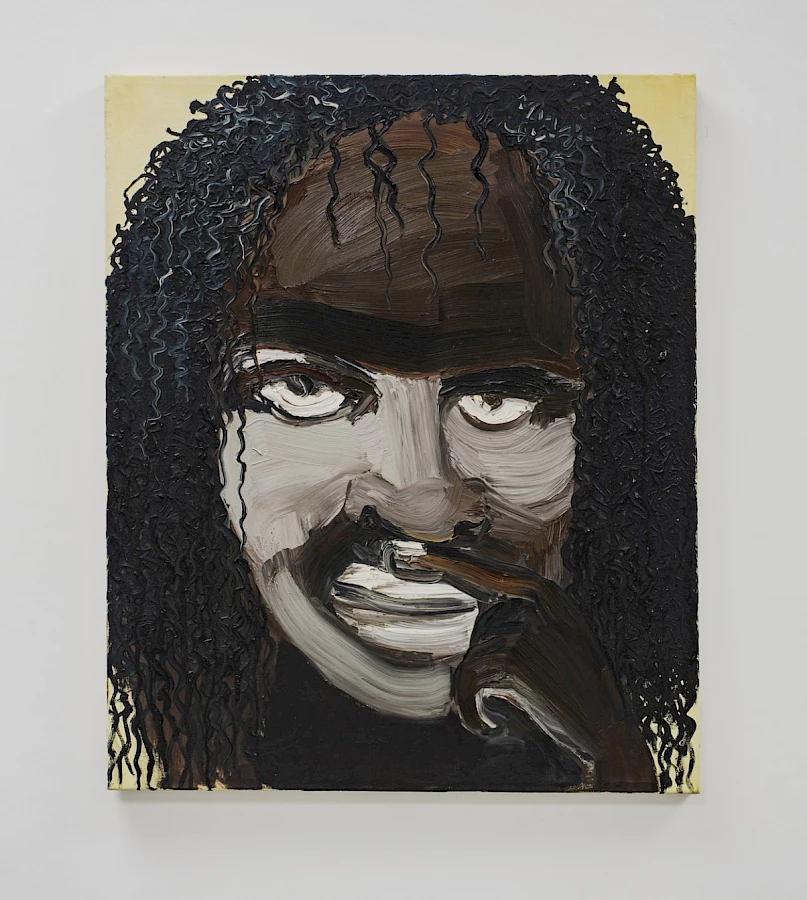
Lynette Yiadom-Boakye, Nourish the Talented, 2003. Photo credit: M HKA.
In Savage Conversations, playwright LeAnne Howe relays the true story of Mary Todd Lincoln, the wife of the president. After the assassination of her husband, she kept complaining to her doctor of experiencing nightly visits from a violent ‘Indian’, who would cut the bones from her cheeks with a scalpel and make slits in her eyelids so to sew them open. In 1862, President Lincoln had given the order to execute thirty-eight Dakota men. In Howe’s play, the dialogue between Mary Todd, the Indian, and a third protagonist is interspersed with short descriptions of artworks that relate to these tragic events. Hauntologies are indeed the matter of dreams and nightmares, but also of identities. These transpire in Warhol’s The American Indian (Russell Means) (1976),60 Jimmie Durham’s Tlunh Datsi (1984), as well as many other works in the exhibition.
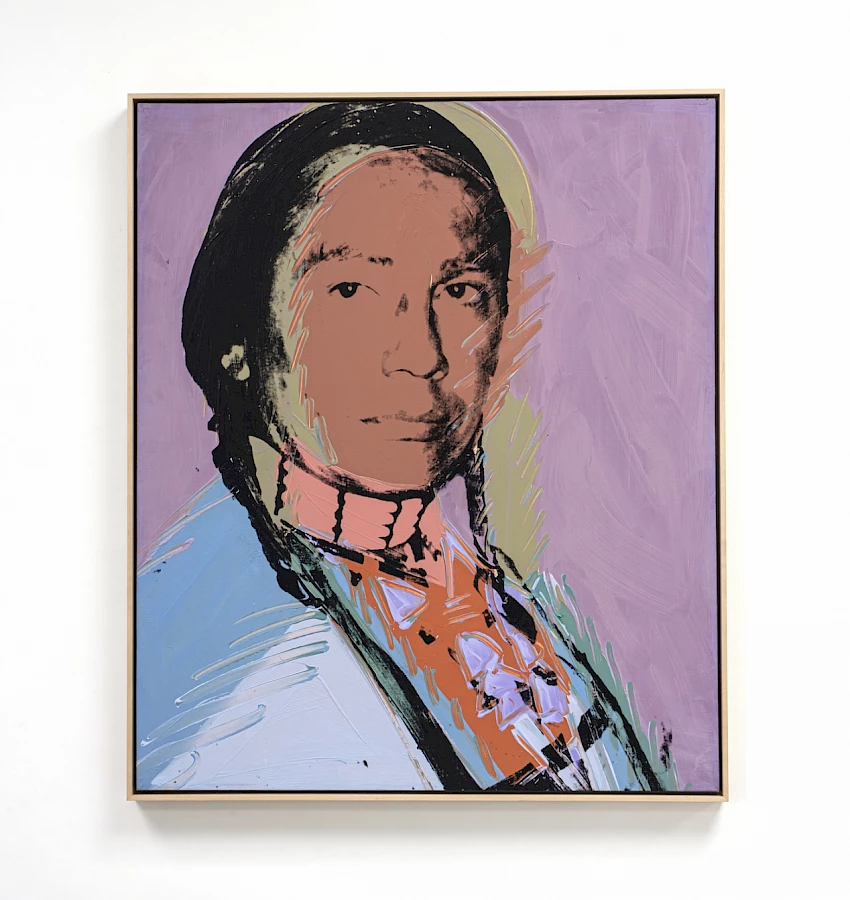
Andy Warhol, The American Indian (Russell Means), 1976. Photo: M HKA.
More broadly speaking, appropriation recurs throughout MONOCULTURE as a series of entre captures61 through which one ingests (and digests) the other while being constantly eaten62 – watch artist Daniel Blandy lip-syncing the song ‘Bring Da Ruckus’ by rap group Wu-Tang Clan, while Wu-Tang Clan ‘samples aesthetics of classic Kung Fu movies from Asia in their music’.63 This is an exhibition where worlds combine and recombine, degenerate, regenerate, gender and de-genre through ‘entangled relation[s] of difference (différance)’64 and ‘mutual indebtedness’.65
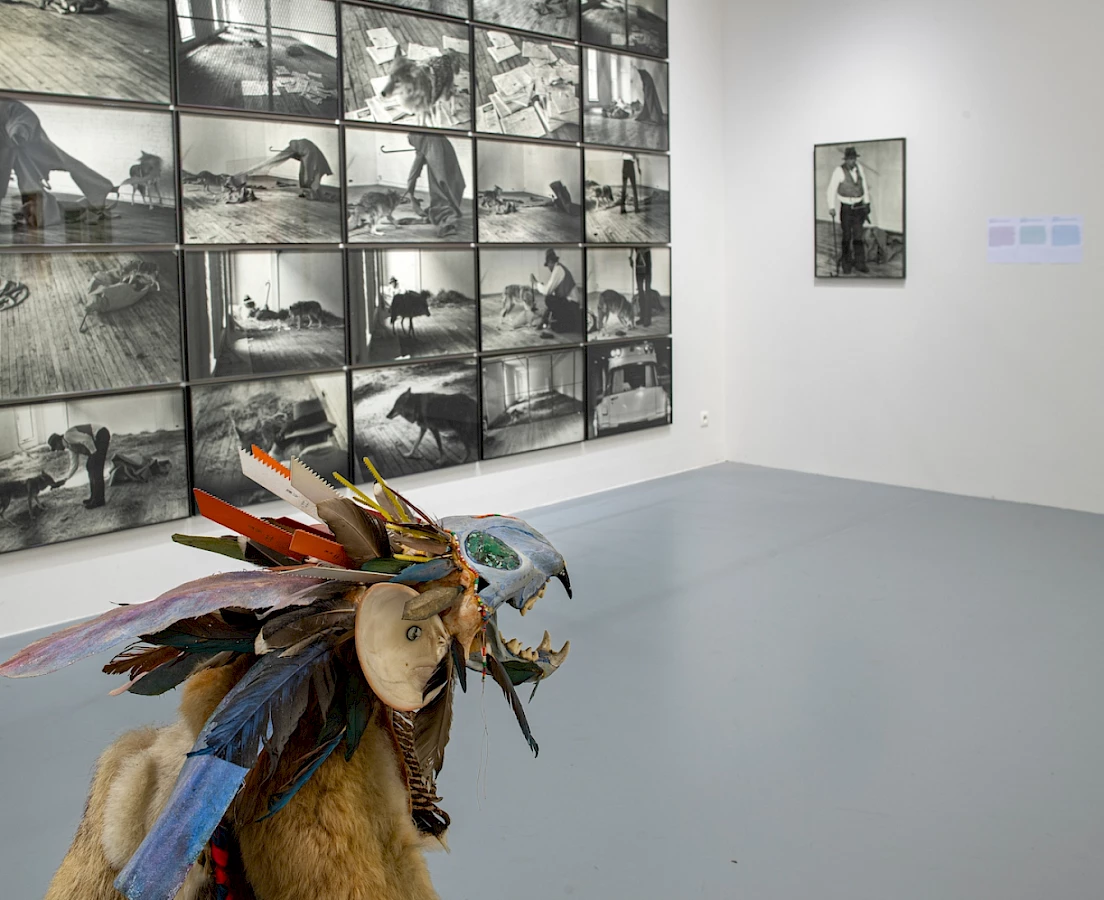
Jimmie Durham, Tlunh Datsi, 1984. Photo: Wim Van Eesbeek.
Degenerations, Contaminations
Derived from Linnaean and Darwinian biology, the term (entartet) is typically translated into English as degenerate, a word that also has its roots in biology, and particularly in eugenics. It means, strictly, that which does not have a classification (artet), that which is excluded from the set of all sets – not just degenerate but de-genred, impossible to classify and therefore impossible (to be permitted to) exist.
–So Mayer, A Nazi Word for a Nazi Thing66
We are contaminated by our encounters; they change who we are as we make way for others. As contamination changes world-making projects, mutual worlds – and new directions – may emerge. Everyone carries a history of contamination; purity is not an option. One value of keeping precarity in mind is that it makes us remember that changing with circumstances is the stuff of survival.
–Anna Lowenhaupt Tsing, The Mushroom at the End of the World
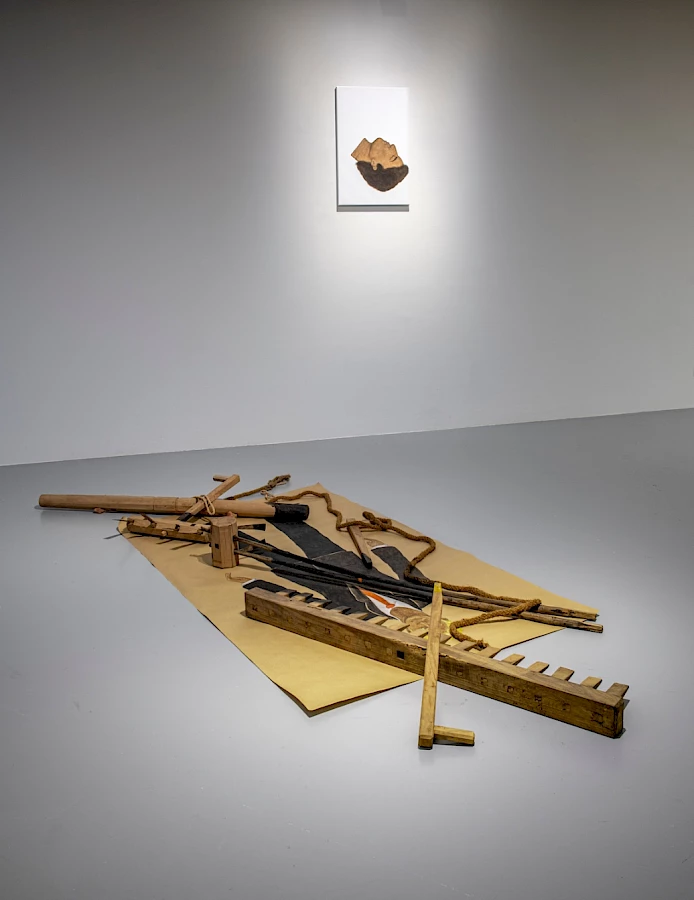
N. S. Harsha, Head, 2008. Photo: M HKA, Wim Van Eeesbeek.
Cha, Theresa Hak Kyung (2001). Dictée, University of California Press, Berkeley, p. 33.
Harris, Will (2018). Mixed-Race Superman: Keanu, Obama, and Multiracial Experience. Peninsula Press, London, pp. 115–16.
Moten, Fred (2017). Black and Blur. Duke University Press, Durham, NC. ‘Consent not to be a single being’ is borrowed from Édouard Glissant.
The conference Considering Monoculture was organised by Nick Aikens (Van Abbemuseum), Nav Haq (M HKA) and Nora Mahammed (deBuren), 27–28 February 2020, deBuren, Brussels, deburen.eu.
Haq, Nav, ed. 2020. Monoculture: A Recent History, exh. cat., M KHA, Antwerp; and Gielen, Pascal and Nav Haq, eds. 2020. The Aesthetics of Ambiguity: Understanding and Addressing Monoculture. Valiz, Amsterdam.
Gielen and Haq, ‘Ambiguity and Monocultures’, introduction to The Aesthetics of Ambiguity, p. 38.
Ibid.
William James quoted in Latour, Bruno. 2011–12. ‘Il n'y a pas de monde commun: il faut le composer’, Multitudes, no. 45, p. 38.
I am using the term ‘container’ in line with Ursula K. Le Guin, ‘The first cultural device was probably a recipient. ... Many theorizers feel that the earliest cultural inventions must have been a container to hold gathered products and some kind of sling or net carrier.’ Le Guin (1988/2019). The Carrier Bag Theory of Fiction. Ignota Books, London, p. 29.
My translation of ‘Le pluralisme mord trop profondément’ in Latour, ‘Il n'y a pas de monde commun’, p. 38.
As Philippe Van Parijs puts it in the context of the conference Considering Monoculture, 28 February 2020.
Da, Nan Z (2020). ‘Disambiguation, a Tragedy: The Diminishing Returns of Distinction-Making’, n+1 38, ‘Death Wish’ (Fall), nplusonemag.com.
Barad, Karen (2012). ’On Touching – The Inhuman That Therefore I Am’, differences 23, no. 3, pp. 206–23.
Ibid., p. 214.
Ibid., p. 217.
Chantal Mouffe took part in the Considering Monoculture conference, 28 February 2020, youtube.com.
Mouffe, Chantal (2013). Agonistics: Thinking the World Politically. Verso, London, p. 40.
Chantal Mouffe borrows here from Henry Staten in ibid., p. 4.
Barad, Karen (2011). ‘Nature’s Queer Performativity’, Qui Parle 19, no. 2 (Spring/Summer), p. 150.
Moten, Fred (2011). ‘An Ecology of (Eloquent) Things’, Hard Truths: A Forum on Art and the Politics of Difference conference, 8 April 2011, youtube.com.
‘Identity is diffracted through itself – identity is diffraction/différance/differing/deferring/differentiating’. Barad, ‘Nature’s Queer Performativity’, p. 126.
I am borrowing here from poet and scholar Edgar Garcia, whose methodologies for delving into our contradictory selves and hauntologies dialogue with the K’iche’ Mayan story of creation, the Popol Vuh, as a ‘seeing device’ for thinking. Reines, Ariana (2020). ‘ANALPHABETIS: A Conversation with Edgar Garcia’, Invisible College (online).
The exhibition MONOCULTURE: A Recent History is approached by curator Nav Haq as a tool for reading images and therefore as a potential tool for emancipation.
Barad, Karen (2003). ‘Posthumanist Performativity: Toward an Understanding of How Matter Comes to Matter’, Signs 28, no. 3 (Spring), p. 803, 3n.
Ahmed, Haseeb (2020). ‘Constituting the Ummah أم’, seminar, Considering Monoculture conference, 28 February.
Mayer, So (2020). A Nazi Word for a Nazi Thing. Peninsula Press, London, p. 23.
The Great German Art Exhibition was restaged in Munich on various occasions between 1937 and 1944.
Mayer, A Nazi Word for a Nazi Thing, p. 44.
Staal, Jonas. 2020. ‘Staging Them: Entartete Kunst from Past to Present’, in The Aesthetics of Ambiguity, p. 60.
Ibid., p. 61.
Ibid., p. 63.
Harris, Mixed-Race Superman, p. 14.
Nav Haq refers to Simone de Beauvoir’s The Ethics of Ambiguity (Gallimard, Paris, 1947), but also to Else Frenkel-Brunswik’s ‘Intolerance of Ambiguity as an Emotional and Perceptual Personality Variable’, Journal of Personality 18, no. 1 (September 1949), pp. 108–43.
Butler, Judith (2004). ‘Endangered/Endangering: Schematic Racism and White Paranoia’, in The Body, A Reader. Routledge, London, p. 17.
Nav Haq, interview by the author, October 2020.
Butler, ‘Endangered/Endangering’, p. 22, 2n.
‘As the cliché goes, history repeats itself, but the fact that it happens again suggests that the multicultural consensus was never a consensus. In short, the Black Lives Matter movement reaffirms “our” monocultural perspective on multiculturalism and what suppresses it.’ Gielen and Haq in ‘Ambiguity and Monocultures’, p. 10.
‘The first identity movement in American politics was the Ku Klux Klan, which still exists.’ Lilla, Mark. 2016. ‘The End of Identity Liberalism’, New York Times, 18 November, quoted in Nav Haq, ‘Ambiguity and Liberalisms: Artistic and Institutional Practices as a Sphere of Cultural Influence’, in The Aesthetics of Ambiguity, p. 47, 3n.
‘Our body itself is the palmary instance of the ambiguous’. William James quoted in Latour, Bruno (2004). ‘How to Talk About the Body? The Normative Dimension of Science Studies’, Body & Society 10, no. 2–3, p. 206.
Ibid.
‘Changes to the past don’t erase marks on bodies; the sedimenting material effects of these very reconfigurings—memories/re-memberings—are written into the flesh of the world. Our debt to those who are already dead and those who are not yet born cannot be disentangled from who we are.’ Barad, ‘Nature’s Queer Performativity’, p. 150.
Olivier Marboeuf, Considering Monoculture conference, 28 February 2020.
So Mayer coined the term “anarchive” in A Nazi Word for a Nazi Thing, p. 73.
Ibid., p. 8.
Ibid., p. 51.
Barad, Karen (2010). ‘Quantum Entanglements and Hauntological Relations of Inheritance: Dis/continuities, SpaceTime Enfoldings, and Justice-to-Come’, Derrida Today 3, no. 2, p. 247.
‘Key to the gentrification mentality is the replacement of complex realities with simplistic ones. Mixed neighborhoods become homogeneous. (…) So for every leaseholder who died of AIDS, an apartment went to market rate.’ Schulman, Sarah. 2013. The Gentrification of the Mind: Witness to a Lost Imagination. California University Press, Berkeley, p. 84.
Preciado, Paul B (2015). ‘Anal Terror’, Baedan 3 – Journal of Queer Time Travel, Contagion Press, p. 128.
Heinrich Himmler (April 1943) quoted in Barad, ‘Nature’s Queer Performativity’, p. 122.
Preciado, ‘Anal Terror’, p. 124.
Preciado, ‘Anal Terror’, p. 128.
Deleuze, Gilles and Félix Guattari (1987). A Thousand Plateau: Capitalism and Schizophrenia, University of Minnesota, Minneapolis, p. 77.
Avishek Ganguly in Monoculture, p. 316.
Choi, Don Mee (2020). Translation Is a Mode = Translation Is an Anti-neocolonial Mode. Ugly Duckling Presse, New York, p. 5.
Derrida, Jacques (1994). Specters of Marx. Routledge, New York, p. 4.
Barad, ‘Quantum Entanglements and Hauntological Relations of Inheritance’, pp. 240–68.
Barad quoting Derrida in ‘Quantum Entanglements and Hauntological Relations’, p. 245.
Warhol’s work also interlaces ‘with activism, celebrity and popular culture’. Haq, Monoculture, p. 206.
Stengers, Isabelle (1997). Cosmopolitiques, Vol. 1. La Découverte, Paris, p. 64.
See the episteme of anthropophagy traced by Christine Greiner in ‘Cultural Cannibalism and the Subversion of Monoculture in Brazil’, in The Aesthetics of Ambiguity, pp. 135–47.
Haq, Monoculture, p. 225.
Barad, ‘On Touching’, p. 217.
Moten, ‘An Ecology of (Eloquent) Things’.
Mayer, A Nazi Word for a Nazi Thing, pp. 8–9.
The views and opinions published here mirror the principles of academic freedom and do not necessarily reflect the views or positions of the L'Internationale confederation and its members.
Related activities
Related contributions
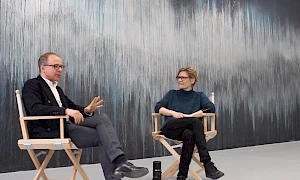
A conversation about the project 'A Temporary Futures Institute'
Art Museums and Democracy
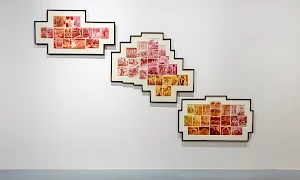
Hauntological Relations of Monocultures
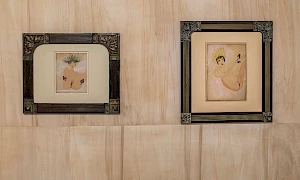
A walk-through the exhibition ‘MONOCULTURE – A Recent History’ at M HKA (Antwerp), with Nick Aikens and Nav Haq in conversation
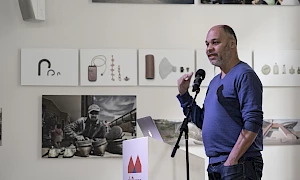
Decolonial Suites
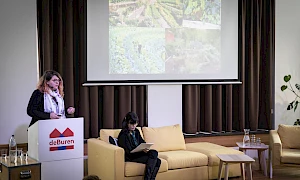
Offsetting Sameness: Notes Towards Artistic and Institutional Polysemy and Practices of/on Monocultures and Multicultures
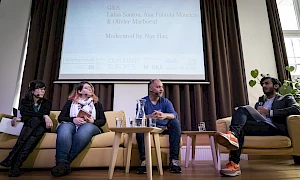
Panel Discussion with Luísa Santos, Ana Fabíola Maurício and Olivier Marboeuf, moderated by Nav Haq
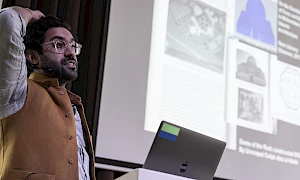
Constituting the Ummah – أم
